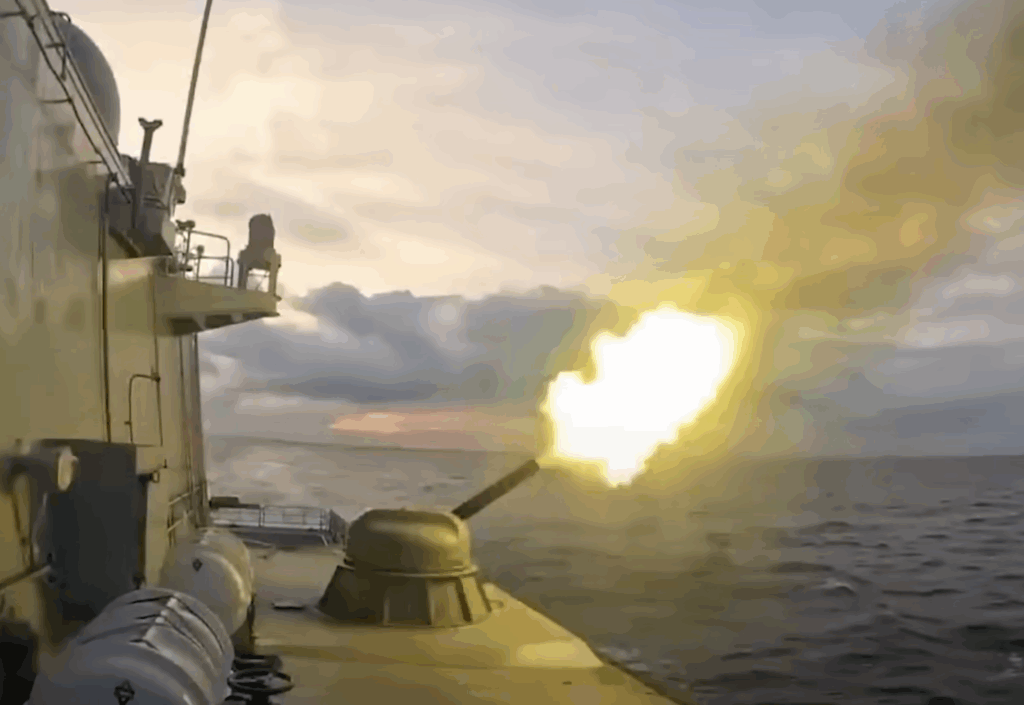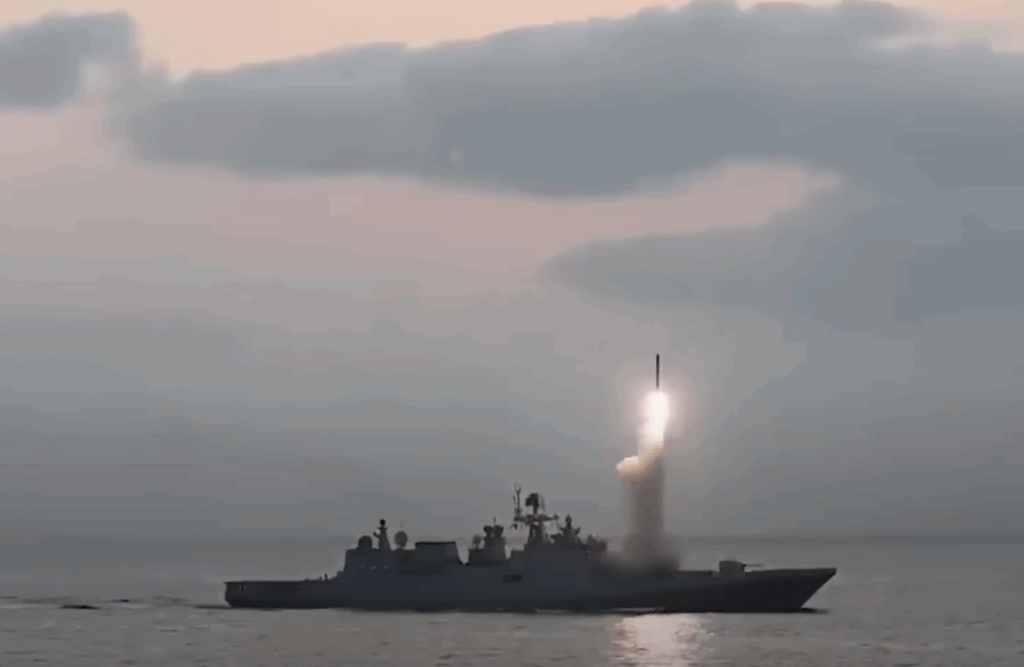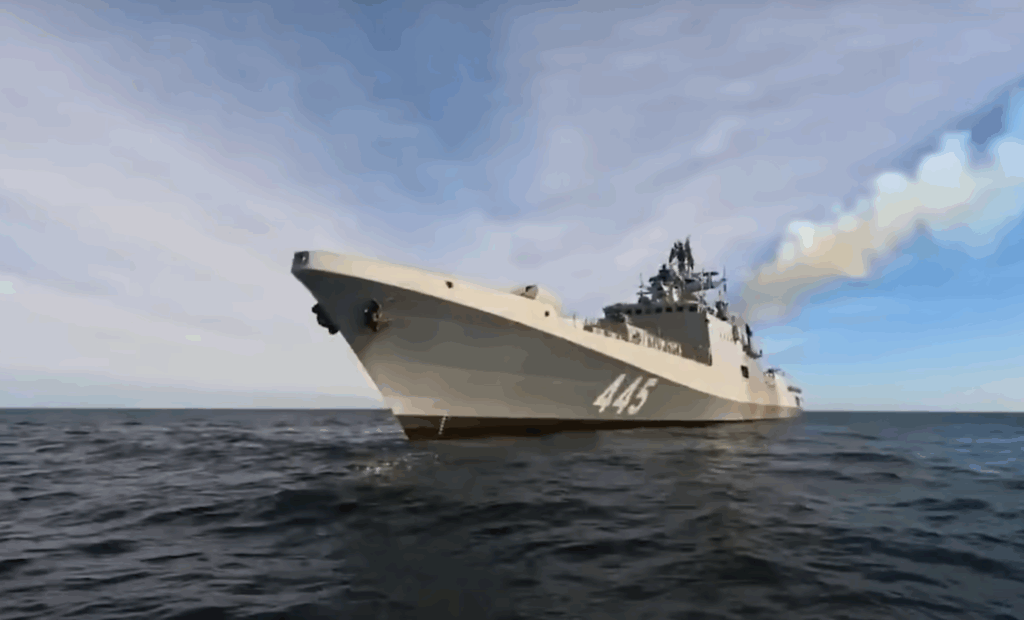In mid-July 2025, Finland’s navy was alerted to an unusual visitor: INS Tamal, a newly delivered Indian Navy frigate built in Russia, was transiting northern European waters. Finnish and Swedish maritime authorities confirmed Tamal reported it was bound for the Bothnian Bay, off Finland’s west coast.
Finnish Navy spokesperson Commander Markus Malila emphasised the ship posed no illegal threat – its brief passages through Finnish waters were being treated as “innocent transit” under international law. He told Ilta-Sanomat no wrongdoing was suspected. As Tamal passed Kristiinankaupunki in the Sea of Bothnia and later reached north of Raahe, Sweden’s navy noted the vessel was in its economic zone near Skellefteå. Both navies declined to explain why Tamal was in the Baltic. In short, officials describe it as an “unusual but lawful” visit.
Tamal is no ordinary Corvette. The 125‑metre, 3,900‑tonne frigate is a “Talwar-class” (Project 1135.6) warship built by Russia’s Yantar shipyard in Kaliningrad. It carries a helicopter pad (with long-endurance range up to 30 days at sea), BrahMos supersonic anti-ship missiles, anti-submarine rockets, a 100mm gun and 30mm anti-aircraft guns. India took delivery of Tamal in July 2025 under a 2016 contract with Russia. In fact, it was part of a series: two sister ships are under construction in India (with ongoing Russian technical support) and due for completion by 2027. Tamal, Sanskrit for Indra’s mythic sword, will join India’s Western Naval Command at Karwar, Karnataka. It is slated to visit several domestic ports to showcase its capabilities.

NS Tamal (F71)
- Class & Design: Talwar-class (Project 11356, upgraded “Tushil” variant) stealth guided-missile frigate—eighth of its kind, built by Russia for India.
- Builder & Commissioning: Constructed at Yantar Shipyard in Kaliningrad; formally commissioned on 1 July 2025 in Kaliningrad, making it the last Indian warship built abroad.
- Significance: Marks a milestone shift as India transitions to domestic shipbuilding under its “Aatmanirbhar Bharat” and Make-in-India programmes.
Specifications & Performance
- Dimensions: Length ~124.8 m; beam ~15.2 m; displacement ~3,900–4,035 tonnes at full load.
- Speed & Range: Top speed ~30 knots (~56 km/h) and a range up to 4,850 nautical miles (~8,980 km), enabling sustained blue-water deployments.
- Crew Capacity: Operated by ~250 sailors and ~26 officers.
Armament & Combat Systems
- Surface-to-Air Missiles: 24 × VLS-launched Shtil‑1 missiles (range ~70 km) and 8 × Igla‑1E short-range SAMs.
- Strike Missiles & Naval Gun: Equipped with 8 × BrahMos supersonic anti-ship/land-attack missiles and a 100 mm A‑190E naval gun for long-range engagements.
- CIWS & ASW Rockets: Dual AK-630 30 mm close-in weapon systems; one RBU‑6000 anti-submarine rocket launcher for quick reaction depth-charge salvos.
- Torpedoes: Two twin-mounted 533 mm torpedo tubes deploying heavyweight ASW torpedoes.
Sensors, EW & Aviation Capabilities
- Electronic Warfare & Decoys: Integrated EW suite with DRDO/Shakti jammers, TK-25E‑5 detectors, and PK‑10 decoy launchers to counter threats.
- Radar & Sonar: Advanced EO/IR targeting systems, BEL HUMSA NG sonar, and surface surveillance radars enhancing detection and situational awareness.
- Aircraft Operations: Supports embarking Kamov Ka‑28 (ASW) or Ka‑31 (AEW), or India’s HAL Dhruv helicopter depending on mission needs.
Indigenous Componentry & Strategic Context
- Local Content: Over 25–26% indigenous systems, including BrahMos missiles, sonar, fire-control, EW, and communication gear supplied by Indian firms like BEL, Tata Nova, Keltron, and others.
- Strategic Role: Post-completion of the four-ship contract (ordered in 2018), the focus will shift to Goa Shipyard producing two similar frigates domestically (Triput and Tavasya), further boosting self-reliance.
- Fleet Assignment: Assigned to the Western Fleet (India’s “Sword Arm”) based at Karwar; symbolically strengthening India’s blue-water capability in the Indian Ocean and beyond.
Expanding Indian Navy

India’s fleet is growing rapidly. New Delhi has pushed its defence budget to record levels, about ₹6.81 trillion, or US$78.3 billion for FY2025-26, although much of that pays salaries and pensions. In the 2024–25 budget, with already record high defence budget of US$785, the budget of the Navy’s capital outlay was about ₹23,800 crore (~$2.8 billion). Planned acquisitions include new aircraft carrier fighters, submarines, survey ships, missile boats and fleet tankers. In keeping with Prime Minister Modi’s “Atmanirbhar” drive, roughly 75% of this spending was earmarked for domestic suppliers, though India still buys or co‑produces key systems. For example, the BrahMos missiles on Tamal are built in an Indo-Russian joint venture. According to DefenceNews, India raised its 2025–26 budget by nearly 10%, but only about 26% of funds went to new hardware. Overall, India’s naval modernisation is well‑funded but faces familiar trade‑offs between foreign purchases and home‑grown projects.
More Than 50 Indo-Russian Naval Ties
The Tamal episode is a reminder of India’s continuing military partnership with Moscow. Over six decades Russia has delivered more than 50 warships to India, from Soviet-era destroyers to modern frigates. Tamal itself is a product of that partnership – one of India’s last foreign-built frigates. Just last summer, in July 2024, the Indian frigate INS Tabar participated in joint drills with the Russian navy, and even China, in the Gulf of Finland. These “Indra” exercises off St. Petersburg are part of a regular Indo-Russian series. On land as well as sea, New Delhi maintains delicate relations: it recently sought closer ties with NATO countries and Japan, yet it remains heavily dependent on Russian energy and arms. Two more frigates of Tamal’s class are being built at Goa shipyards with Russian help, and India buys advanced combat aircraft, like the SU-30, and tanks from Russia as well.
Going Global
India’s navy is no longer just a regional force. Indian warships routinely operate far from home – conducting anti-piracy patrols in the Gulf of Aden, exercises with the US, Australia and Japan (QUAD partners) in the Indian Ocean and Pacific, and port visits to African and Middle Eastern countries. In 2022 India even took part in a Russian naval parade celebrating Indian Navy Day in the Bay of Bengal. The Baltic sighting may reflect that global scope more than any sinister purpose. However, it does raise questions about strategy: is this a familiar sea trial route, a goodwill visit, or something else? Indian defence analysts note that cooperation with NATO‑aligned countries has grown, yet joint exercises with Russia continue. Tamal’s appearance on the Baltic contrasts sharply with India’s Western alliances but illustrates Delhi’s independent streak in foreign policy.
Signalling Support for Russia’s Oil Route
Part of the anxiety around Tamal comes from energy politics. India is Russia’s top oil customer – buying roughly 35–40% of its crude in 2024. The EU’s recent oil sanctions, including a lowered price cap, theoretically favour Indian refiners by making Russian oil cheaper. Russia has responded by assembling an illicit “shadow fleet” of old tankers, mostly acquired from Western companies, to evade Western scrutiny. These vessels often trade under flags-of-convenience and lack Western insurance. India has, so far, taken a mixed line: Mumbai insists it honours only UN sanctions, not unilateral EU/UK blacklists. Indeed, last spring India even refused entry to one sanctioned ship, Andaman Skies, over paperwork issues. There is no evidence India’s navy is escorting the shadow fleet; on the contrary, New Delhi has publicly downplayed the move as a routine transit. Still, Western observers worry that the Tamal sighting could signal tacit support for Russia’s oil routes – or at least be a goodwill gesture in return for energy ties.
Shadow Fleet in the NATO Sea
The Bothnian Bay and Gulf of Finland have become tense neighbourhoods. In December 2024 Finland seized the oil tanker Eagle S, a Cook Islands–registered vessel, on suspicion it had cut an undersea power cable. Finnish authorities noted Eagle S was likely part of Russia’s sanctioned “shadow fleet”. NATO immediately vowed to reinforce its Baltic presence after these and other sabotage incidents. Finnish officials report dozens of suspicious oil tanker sightings each month, alongside frequent Russian warship patrols. The web of undersea cables, pipelines and sea lanes here is now a strategic flashpoint. In that light, an Indian frigate prowling the area inevitably drew attention, even if it means no provocation was intended.
Read More:
- Naval News: Russian Navy corvette escorts Shadow Fleet tankers in the English Channel
- Naval News: Indian Navy Inducts Last Imported Warship; INS Tamal Commissioned in Russia
- YLE: Suomenlahdelle ilmaantunut intialaisfregatti on Venäjän ja Intian laivastoyhteistyön uusin esimerkki (in Finnish)
- Defense News; India raises defense budget by nearly 10%, pushes local manufacturing
- ZM: A Russian Navy corvette and an Indian Navy frigate conducted training exercises in the Gulf of Finland
- SP’s Naval Forces: Defence Budget 2024-25 — An Analysis (India)
- Reuters: NATO to boost Baltic Sea presence after cables broken
- Maritime Executive: Report: India Turned Away Shadow Fleet Tanker Laden with Russian Oil
- Brookings: Where did Russia’s shadow fleet come from?
- The Times of India: Russia Crude Oil Restrictions – EU Imposes Sanctions on Rosneft’s India Refinery, Lowers Oil Price cap How It May Benefit India
- YLE: Hämärän laivat maailman merillä – Venäjän varjolaivasto vie kallista venäläisöljyä pakotteista huolimatta (in Finnish)
- Indian Ministry of Defence: INS Tamal, Latest Stealth Frigate Commissioned Into Indian Navy
- Wikipedia: INS Tamal
- Wikipedia: Talwar-class frigate
- IndiaTV: INS Tamal commissioned in Russia: Indian Navy’s last foreign-built warship joins the fleet
- YouTube: INS Tamal: Last Foreign-MadeFrigate To Join Navy
- IndiaExpress: INS Tamal commissioned: All about its capabilities, why it may be the Indian Navy’s last imported warship



